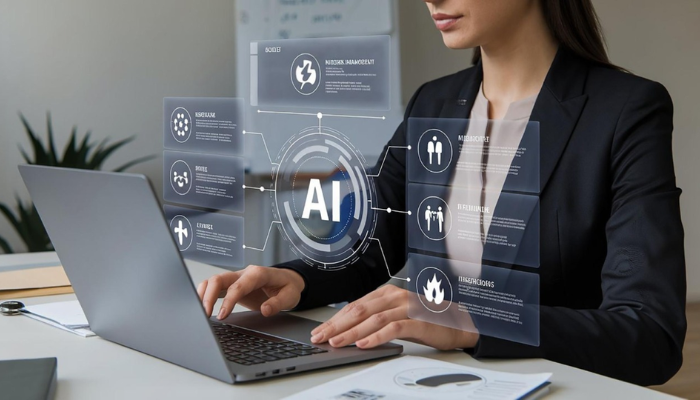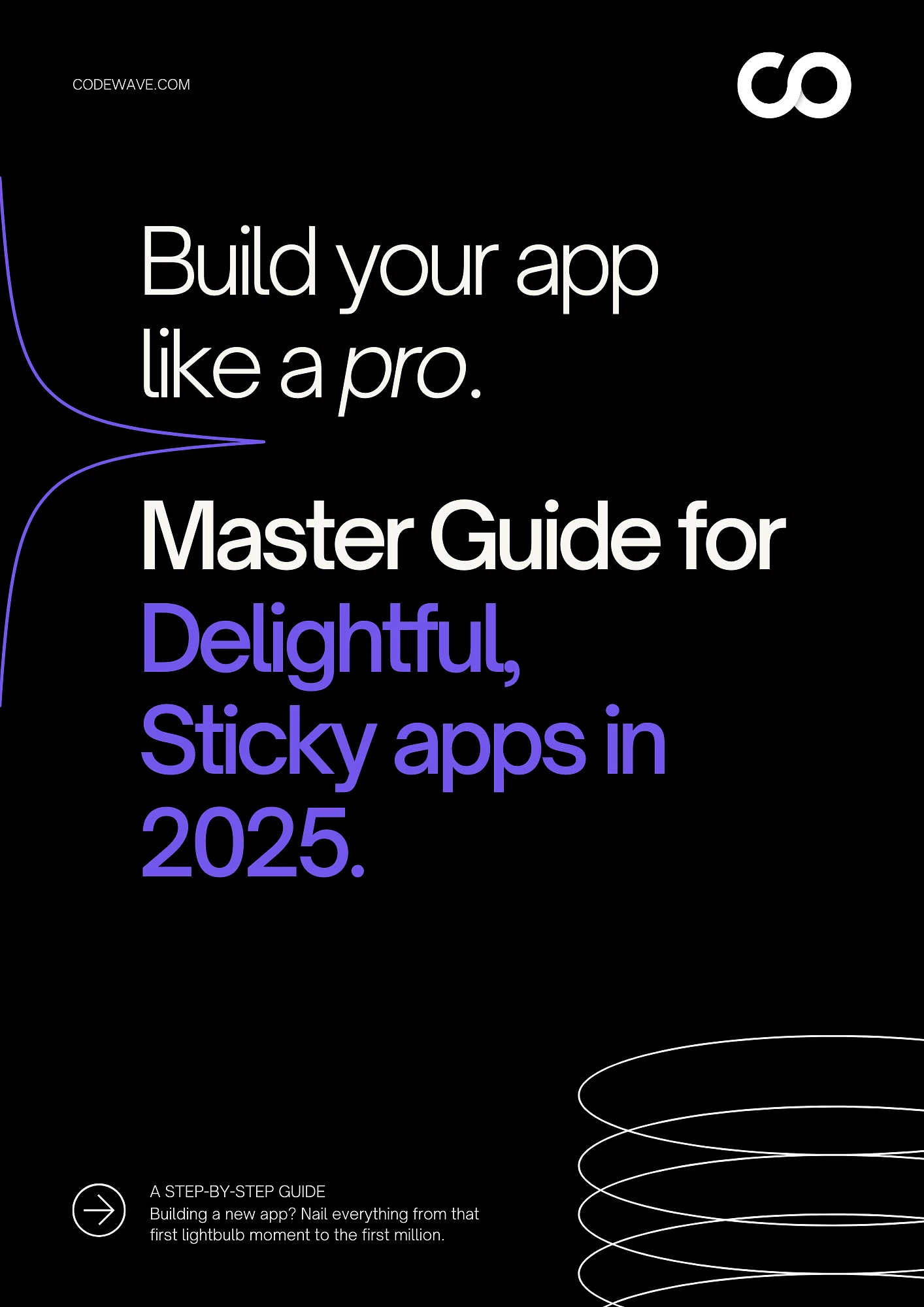When you’re shopping for furniture online, wouldn’t it be helpful to see how that new sofa fits into your living room? This is where extended reality app development comes in, blending the physical and virtual worlds for a more interactive and engaging experience.
The XR field is rapidly advancing, with over 7,620 patents secured and a yearly growth rate of 14%, driven by industry leaders like the US and China. However, many apps struggle with performance issues or clunky interfaces, which can make the experience less engaging.
In this article, you’ll see how to build smooth, intuitive XR apps with the right tools, design, and development strategies.
TL;DR
- XR Types: VR immerses you fully in a digital world, AR overlays digital content on the real world, and MR allows real-time interaction between digital and physical elements.
- Choosing the Right Tool: Platforms like Unity and Unreal Engine are perfect for VR, AR, and MR projects, depending on the complexity and level of immersion you need.
- Codewave’s Expertise: Codewave specializes in tailoring XR solutions to your business needs, integrating advanced AI for impactful, immersive experiences.
What is Extended Reality? Key Components and Types
Suppose you’re working on a complex engineering project and need to visualize a product prototype. With extended reality app development, you can project a 3D model of your design into the physical space, interacting with it in real time.
This allows you to test dimensions, functionality, and make adjustments before the actual prototype is built. To make this possible, it’s crucial to understand some key components behind XR.
- Hardware
Think about the headset you use for gaming or the AR glasses you wear at work. These devices are the first step in any XR experience.
For example, a surgeon might use a mixed reality headset to view 3D images of a patient’s organs during surgery, helping them plan their approach in real-time.
- Sensors and Tracking
Ever notice how a VR headset knows where you’re looking or how you’re moving? That’s sensors at work. They track your head, hand, or body movements to make the digital experience feel natural.
For instance, in a fitness app, sensors track your body’s position to show accurate postures while you’re following along with a workout routine.
- Software
Software makes the magic happen. It’s what developers use to create the XR experiences you interact with. Think of a mobile app that lets you see how a new sofa fits in your living room.
Behind that, software handles the 3D models, camera integration, and the interactive design that makes the whole thing work smoothly.
- User Interface (UI) and User Experience (UX)
In XR, how you interact with the system is crucial. If the UI is complicated, it could make the experience frustrating.
A good interface ensures that controls are intuitive, allowing you to easily manipulate the digital objects around you, whether it’s with gestures or voice commands.
- Real-Time Data Processing
XR systems need to process data as you interact with them. This is key when you need instant feedback. In a driving simulation, as soon as you turn the wheel, the system has to process the data to change the view instantly.
Without quick data processing, the experience would feel laggy and disjointed.
Now that you’ve got the basics, let’s look at how these components come together in different types of XR experiences.
Types of Extended Reality (XR)
When it comes to extended reality (XR), there are three main types: Virtual Reality (VR), Augmented Reality (AR), and Mixed Reality (MR). Each type offers a different way of blending the digital and physical worlds, depending on how you interact with the technology.
Let’s break them down.
| Aspect | Virtual Reality (VR) | Augmented Reality (AR) | Mixed Reality (MR) | Extended Reality (XR) |
| Immersion Level | Fully immersive; completely blocks out the real world. | Enhances real world with digital elements, but doesn’t block it out. | Combines both worlds, with interactive digital objects in the real world. | Includes all levels of immersion (from full to partial immersion). |
| User Interaction | User interacts with a completely virtual environment (headset, controllers). | User interacts with digital elements placed on real-world objects via phone or AR glasses. | User interacts with both real and virtual elements, allowing for real-time adjustments. | Interaction varies based on the type (VR, AR, MR) being used. |
| Real-World Integration | No real-world integration; everything is digital. | Digital elements are overlaid on top of the real world (e.g., product previews). | Real and digital objects coexist and interact in real-time (e.g., manipulating a virtual object on a physical surface). | Combines all forms of real-world integration, depending on the XR type. |
| Usage Scenario | Gaming, training simulations, virtual tourism. | Retail apps, navigation, maintenance work, education. | Design, engineering, remote assistance, advanced education. | Broad application across industries, from gaming and entertainment to healthcare and education. |
| Technology Complexity | High; requires specialized hardware (VR headsets, controllers). | Moderate; uses smartphones, AR glasses, or smart devices. | Very high; involves sensors, real-time processing, and complex integration. | Varies based on the type used; ranges from simple AR apps to complex VR systems. |
Struggling to create an XR experience that truly engages your customers or enhances your training programs? Explore Codewave’s XR Application Development services, where we help turn your concepts into interactive, immersive experiences. Let’s bring your ideas to life!
At Codewave, we focus on creating extended reality (XR) solutions that fit your specific business needs. Whether it’s building VR training simulations, AR shopping experiences, or MR design tools, we help bring your ideas to life with the right mix of technology and creativity.
Next, let’s take a look at the platforms and tools that power extended reality app development.
Extended Reality App Development Platforms and Tools
Let’s say you’re building a virtual showroom for your brand, where customers can explore products interactively through VR or AR. You might consider platforms like Unity or Unreal Engine for development, and tools like Vuforia for AR.
But with so many options out there, choosing the right platform and tools for your specific needs can feel overwhelming.
Let’s take a look at the platforms and tools you’ll need to bring your XR ideas to life.
1. Unity
Unity is a versatile platform that supports both VR and AR app development.
- Ideal For: Beginners to advanced developers who want a flexible, all-in-one development environment.
- Key Features:
- Cross-platform support for mobile, desktop, and consoles
- 3D/2D rendering engine for immersive graphics
- VR/AR templates to quickly get started
- Asset store with ready-to-use 3D models and components
- Extensive community and documentation for learning
2. Unreal Engine
Unreal Engine excels at creating high-performance, visually stunning XR experiences, particularly for VR apps.
- Ideal For: Intermediate to advanced developers, especially those focused on delivering high-quality graphics and immersive experiences.
- Key Features:
- Real-time 3D rendering with advanced lighting and physics
- Pre-built VR templates for easy setup
- VR-specific tools and settings for optimized performance
- High-quality visuals ideal for gaming and simulations
- Blueprint scripting for easier development without heavy coding
3. Amazon Sumerian
Amazon Sumerian is a browser-based platform that simplifies creating XR experiences, making it accessible without a heavy coding background.
- Ideal For: Beginners or those seeking to quickly create and deploy AR/VR experiences without in-depth coding knowledge.
- Key Features:
- No-code platform for quick prototyping and development
- Cloud integration with AWS for easy scaling and storage
- Built-in templates for VR/AR projects
- Supports voice, gesture, and 3D object interactions
- Simple drag-and-drop interface for beginners
4. CryEngine
CryEngine is designed for creating advanced VR/AR simulations, offering high-end graphics and powerful real-time rendering capabilities.
- Ideal For: Experienced developers looking to push the boundaries of graphics and simulation quality.
- Key Features:
- Real-time 3D engine with high-performance rendering
- Support for realistic graphics and detailed environments
- Built-in VR support with native VR interaction models
- Advanced physics engine for realistic simulations
- Powerful terrain and environment creation tools
5. Blender
Blender is a powerful open-source tool for 3D modeling, animation, and rendering, ideal for creating assets for XR apps.
- Ideal For: Beginners to advanced developers who need a versatile and free tool for creating 3D models and animations.
- Key Features:
- 3D modeling, sculpting, and rigging tools
- Animation and simulation for creating lifelike movements
- Built-in rendering engine for high-quality visuals
- Export support for popular XR platforms like Unity and Unreal
- Extensive community and tutorials
6. Maya
Maya is a professional 3D animation and modeling software used for creating highly detailed XR content.
- Ideal For: Experienced artists and developers focused on creating complex, high-quality 3D models and animations.
- Key Features:
- Advanced 3D modeling and texturing tools
- Powerful animation and rigging for realistic movements
- High-quality rendering support for realistic visuals
- Compatible with Unity, Unreal Engine, and other XR platforms
- Extensive plugins and third-party integration
7. Vuforia
Vuforia is an AR development platform focused on providing robust tools for creating interactive AR experiences.
- Ideal For: Developers looking to create AR apps with image and object recognition capabilities.
- Key Features:
- Image recognition and object tracking
- Multi-device support (iOS, Android, UWP)
- Cloud recognition for storing and retrieving AR assets
- Supports 3D object placement and interaction
- Integration with Unity for easy AR app creation
8. ARCore (Google)
ARCore is Google’s platform for building AR apps on Android, offering tools for motion tracking and environmental understanding.
- Ideal For: Developers looking to create AR apps specifically for Android devices.
- Key Features:
- Motion tracking and environmental understanding
- Light estimation for realistic AR experiences
- Augmented reality APIs for app development
- Cross-platform support with Unity and Unreal Engine
- Depth sensing for more interactive AR features
9. ARKit (Apple)
ARKit is Apple’s AR development platform, providing a suite of tools for creating AR experiences on iOS devices.
- Ideal For: Developers creating AR apps specifically for iPhones and iPads.
- Key Features:
- Scene understanding and motion tracking
- Face and body tracking for personalized AR experiences
- Light and environment estimation for realistic interactions
- Object detection and tracking
- Seamless integration with Unity and Unreal Engine
Now that you’re familiar with the top XR tools and platforms, let’s look at how to choose the right one for your project.
- Consider the Type of XR Experience You’re Building
If you’re creating a simple AR app for furniture placement, Vuforia or ARCore might be enough. But if you’re working on a complex VR game with detailed environments, Unreal Engine is likely a better choice due to its high-quality graphics.
- Think About Your Target Platform
Will your app be for mobile devices, desktop, or VR headsets? For iOS apps, ARKit is a no-brainer, as it’s built specifically for Apple devices. On the other hand, ARCore is designed for Android apps, offering great support for motion tracking and light estimation.
If you’re developing for both platforms, Unity might be your best bet, thanks to its cross-platform capabilities.
- Match the Tool to Your Skill Level
If you’re just starting out and want to quickly build something, tools like Amazon Sumerian are a great fit—they allow you to create simple AR/VR apps without coding. But
if you’ve got experience in 3D modeling or animation, Blender or Maya can give you the precision and flexibility needed to create detailed assets for your XR app.
- What Kind of Graphics and Performance Do You Need?
If your app requires highly detailed graphics, such as a virtual showroom or architectural visualization, Unreal Engine is a strong option. It’s known for stunning visuals and performance, ideal for creating lifelike 3D environments.
On the other hand, if you need to create more interactive, less graphic-intensive experiences, Unity or ARCore may suffice.
- Consider the Complexity of Interactions
Some apps need advanced interactions like hand tracking or object manipulation. Microsoft Mixed Reality Toolkit (MRTK) is great for creating MR experiences with hand and voice input.
If you’re just placing virtual objects in a room for users to interact with, Vuforia provides the basic tools for image recognition and object tracking without much complexity.
- Look at the Learning Curve
If you’re new to XR development, you’ll want to choose a tool that doesn’t overwhelm you with steep learning curves. Amazon Sumerian offers a simple, no-code interface to get you started, while CryEngine or Maya might require more experience due to their advanced features and capabilities.
Is your user experience falling short of expectations? Explore Codewave’s Customer Experience Design (CX Design) services, where we craft seamless, user-centric experiences that keep your customers coming back. Get started today!
With the right tools in hand, let’s take a closer look at how to bring your extended reality app development project to life.
How to Develop an Extended Reality Project: Step-by-Step Guide
Let’s say you’re building a VR training simulation to teach new employees how to operate heavy machinery. Let’s break down how to develop this project from start to finish.
1. Define the Project Goal
The first step is to define the core objective of your VR training app. In this case, the goal is to provide an immersive, interactive environment where employees can learn the proper procedures for operating machinery, without the risks of working on the actual machine.
2. Choose the Right Platform & Tools
You need to decide which platform will work best for your VR training simulation.
- VR Platform: Unreal Engine (for high-end, realistic graphics) or Unity (more flexible and user-friendly).
- VR SDK: Oculus SDK (if using Oculus headsets), SteamVR (for multi-device compatibility).
Tip: Start with Unity if you’re new to VR development; it has great tutorials and a large community for support.
3. Design the User Experience (UX)
Next, sketch out how the training session will flow.
Will employees start with a tutorial on basic controls? Should they be able to pause and review certain steps?
Visualizing the flow will help you define the key actions.
Example:
- Step 1: Employees start by being introduced to the VR environment, including a virtual machine.
- Step 2: Users practice specific actions (turning knobs, pressing buttons, etc.).
- Step 3: Once familiar, they perform tasks under simulated conditions, like troubleshooting or emergency procedures.
Tip: Keep the interaction simple but informative. The training should be intuitive and allow employees to interact with the machine without getting lost in complex controls.
4. Create 3D Models & Assets
Since your simulation needs to feel realistic, you’ll need accurate 3D models of the machinery. Blender is perfect for creating the models of the equipment, while Maya is another excellent choice for high-quality, professional models.
Tip: Focus on getting the key machinery elements right, like buttons, levers, and control panels, ensuring they mimic real-life functionality.
5. Build the Core Functionality
This is where you make the machinery interactive. Implement functionality like clickable buttons, lever movements, and machine controls using Unity’s or Unreal Engine’s built-in tools.
Example:
- Buttons: Use Unity’s OnClick() function to simulate pressing buttons.
- Levers: Implement lever mechanics with Unity’s Rigidbody physics for realistic movement.
- Controls: Use the Oculus SDK for input controls like hand gestures or controllers to interact with the virtual machinery.
Tip: Keep interactions simple to avoid overwhelming the user. Test early and often to ensure the mechanics are intuitive.
6. Set Up Virtual Environment & Scenario
Design the surroundings where the training will take place. This could be a factory floor, maintenance room, or any environment related to the machinery.
Example:
- Lighting: Set up proper lighting to simulate working conditions (bright for day shifts, dimmer for nighttime).
- Environment Objects: Add tools, lockers, and machinery to enhance the realism of the training environment.
Tip: Focus on key details like safety features (fire extinguishers, emergency stops) and ensure everything in the environment can be interacted with for a complete training experience.
7. Optimize, Test, and Launch
Once you’ve built the core interactions, it’s time to make sure everything runs smoothly. VR is demanding, so performance is key.
- Optimize Performance:
- Use Unity’s Profiler or Unreal Engine’s built-in performance tools to monitor your app’s performance.
- Aim for at least 60fps to ensure a smooth and immersive experience.
- User Testing & Feedback:
- Test the simulation with real users, preferably employees who will be using the system.
- Focus on feedback about:
- Ease of interaction: Can they quickly learn how to control the machinery?
- Realism: Does the VR environment match the actual equipment they’ll use?
- Usability: Is the training intuitive or confusing?
- Deploy & Launch:
- Once testing is complete and you’ve integrated the feedback, you’re ready to deploy.
- Package your app for the platform you’re using (e.g., Oculus, SteamVR) and ensure it meets submission guidelines.
- If you’re launching internally, make sure it’s easy to install and run across the devices used for training.
8. Post-Launch Maintenance & Updates
Once your VR training simulation is live, the work doesn’t stop.
- Monitor Usage: Track app usage, performance, and identify any emerging issues or bugs.
- Gather Feedback: Collect ongoing feedback from users through surveys or in-app tools to pinpoint areas for improvement.
- Update Regularly: Roll out bug fixes, performance enhancements, and platform updates to maintain compatibility.
- Expand Content: Add new training modules or scenarios based on user needs and feedback.
- Keep It Fresh: Refresh content occasionally with new challenges or features to keep the training engaging and relevant.
Now that you’ve got the basics of extended reality app development, try experimenting with gesture tracking and environmental mapping to elevate user interactions.
For businesses looking to integrate XR into their operations, Codewave offers tailored solutions to help bring advanced XR projects to life.
Feeling overwhelmed by outdated systems or struggling to adapt to digital changes? Explore Codewave’s Digital Transformation services, where we help modernize your business processes, optimize workflows, and enhance customer interactions. Get started today!
Why Choose Codewave for Extended Reality App Development?
When your business looks to implement immersive, interactive XR solutions, you need more than just a basic application. At Codewave, we help you move beyond conventional methods by turning your ideas into fully realized, data-driven extended reality experiences.
Our AI-powered frameworks for XR development combine advanced machine learning, real-time data integration, and intuitive design to help you create impactful VR, AR, and MR applications.
Curious to see how Codewave’s XR solutions can make a real difference? Check out our portfolio to explore how we’ve helped businesses like yours transform their ideas into immersive, interactive experiences.
What You Get with Codewave’s XR Development Services:
- 60% improvement in the speed and efficiency of your XR app development process.
- 3x faster deployment, enabling quicker go-to-market timelines.
- Save up to 3 weeks every month by streamlining development and reducing manual intervention.
- 25% reduction in development costs through smart automation and AI-driven optimization.
Our Services Include:
- XR Strategy Consultation: We assess your current XR vision and tailor a roadmap that aligns with your business goals, ensuring scalability and long-term success.
- XR Solution Design & Development: From initial concept to deployment, we build immersive AR, VR, and MR solutions that engage users and enhance business operations.
- AI Integration for XR: We integrate advanced AI into your XR applications, enabling real-time data analysis, personalized experiences, and predictive analytics.
- Interactive Dashboards & Analytics: We provide the tools needed for you to gain valuable insights from your XR data, empowering quick decision-making and performance tracking.
Curious to see what your data is really capable of? Book a free demo with Codewave’s experts and discover how we can turn your data into real results.
Codewave is a UX first design thinking & digital transformation services company, designing & engineering innovative mobile apps, cloud, & edge solutions.







